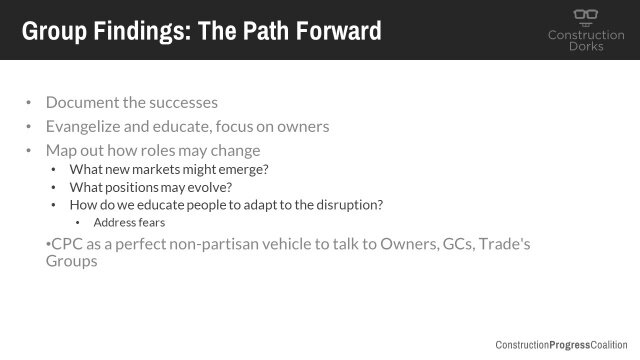Inconceivable!!
I started this blog post on my flight to the MCAA Technology Conference while the blog post I’ve been intending to write for quite awhile. It’s inconceivable to me that it’s been 60 days since our little shindig down in Dallas. But you know what they say…
Time flies…
Many of those interested already know the outcome from the event in Dallas, but there may be some of you that may have been sitting there thinking “Hey, I wonder what happened, what did they talk about?” Well, we talked about a lot but it all came back to one central theme. I’ll recap the presentation we gave to the Construction Progress Coalition (CPC) delegates earlier this year to fill you all in on what went on, what were the findings, and what are the next steps that are coming.
As you can see, we had roughly 40ish people from Architecture, Engineering, and Construction (AEC) and technology gathered to breakdown three topics: The Evolving Supply Chain, Analog to Digital Workflows, and, everyone’s favorite, DfMA - Design for Manufacture and Assembly. The group was heavy on the contractor side, particularly with a large representation of the mechanical specialty trades.
Believe it or not this group was actually pretty productive
If my previous blog posts haven’t beaten it to death, I’ll briefly outline the way we structured the event. We took those three topics and split the group up. The DfMA group ended being the largest, then Analog to Digital Workflows, and finally Evolving Supply Chain. We split the morning up into three activities while keeping an open, free flowing round-table discussion feel. The three activities we all ran through were the Anchors (what’s keeping us stuck in the current processes) to Rockets (what’s been happening or could happen to help propel us to a better future). We then ran through mapping the Shared Pains where we mapped the current processes to understand those Anchors even better as well as to discuss places where the process could pivot. Finally we said Disrupt the System. Describe that Moonshot. What would the ideal state be and what Rockets are there that could take us to the moon?
I am not going to go into each group’s findings or review each activity, that would make for a much too long post, but I will highlight a bullet in the slide above. This theme of the current process being “Design to bid, not design to build” was something that each group came to on their own. Granted we had several people in the room with similar backgrounds and coming from similar personas, it was still interesting to see that each group came to the same conclusion on where perhaps the bulk of the problem lies. This is where, from a CPC point of view, things pivoted and we changed the title of one of our Common Data eXchange (CDX) initiatives from dealing with Submittals to Design to Fabrication.
I believe that this new focus is pretty exciting. Each group coming to a consensus that we didn’t need to outright fix design, but if we can change the bidding process in a way that allows the proper stakeholders to get involved earlier on. The project can be designed in a way that is collaborative. Decisions can be made sooner, input on constructability as well as fabrication and modularization can be made from the subject matter experts who put the work in place will allow for submittal process to become all but obsolete. Then the analog workflows we have in communicating during the current final phase of design which, as Josh Bone points out, are the shop drawings. If we can kick all of that to the front of the project, planning like we should be instead of the race to the bottom in the low-bid process then the scramble to make up schedule, we can really thrust this industry forward and remove those self-imposed barriers to progress.
That’s a very brief… brief of what we went over, compressed into a few paragraphs it maybe doesn’t sound as impactful as it felt in the moment, but hopefully I did a decent giving a hint of where we started and how we came to the conclusions we did. I am going to share two more slides that help now illustrate where we think we should be going next.
Do you sense a theme?
That is what Josh’s group came up with. I am sure you can see a thread of similarity in here with what my group, the Evolving Supply Chain came up with, then we loop in what Nathan Wood and DJ Phipps’ group The Analog to Digital came up with.
Then finally a slide relating what we’re looking to do next, what we think the CPC should focus on in the coming year to drive these findings out into the industry. We realize that there were many personas missing in our discussion. Along those lines, we’ve been lucky to have Jeff Sample involved and are very fortunate in that we have the opportunity next week to speak with the Construction Users Round Table.
Onward and upward!
We’re planning on replicating our refined process using the takeaways from Dallas with this group to help fill that gap of having an Owner’s perspective represented. My intent is to continue to push the ideas out there, to have more events with other groups, perhaps of Engineers and Architects, Suppliers, and any and every stakeholder in a project team.
I want to thank everyone involved in helping make this a successful event and believing that we can collectively make our industry better. There are too many thanks to list them all, but I hope each of you who were able to take part felt the same energy, the same excitement I did and will take a small flame from Dallas and use it to light the torches of change in your region or your particular areas and specialties in the construction process. Be on the lookout for more blogs soon as I feel like I am getting the writing bug and I will definitely have something to write about again after our meeting with CURT.







